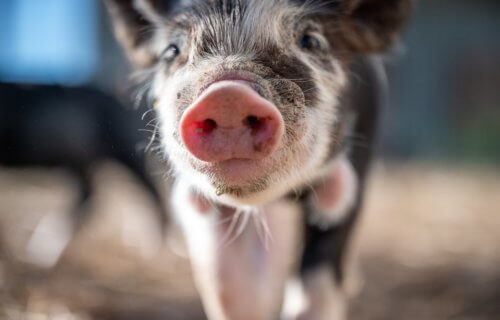SEATTLE, Wash. — An adorable mini pig and a person with sleep apnea don’t seem like they have much in common, that is until you hear both of them snore. Researchers from the University of Washington say a study of how these animals breathe during the night may unlock what scientists need to know to prevent potentially fatal cases of sleep apnea.
The condition is a serious sleep disorder that happens when a person’s breathing is interrupted during sleep. Sleep apnea occurs in around one in four men and one in 10 women. People with untreated sleep apnea can stop breathing repeatedly during their sleep, even hundreds of times each night. Without treatment, it can trigger other health issues including high blood pressure, stroke, diabetes, and heart attacks.
Researchers say that obese, snoring, mini pigs are ideal for showing how air flows through the throat during sleep apnea.
Pigs with the same sleep problems as people
The team discovered that obese Yucatan mini pigs do have naturally occurring sleep apnea. MRI scans taken while the animals were in a sedated sleep can help provide new insights into what happens in the airways of humans during sleep apnea episodes via computational flow dynamic (CFD) analysis.
Since sleep apnea currently has only a few cumbersome or invasive treatments, Prof. Liu and his colleagues set out to better understand the mechanism behind the condition. They looked at two obese and three normal weight Yucatan mini pigs in part because of their comparable airway structure and size to humans.
“These are very fat pigs,” study first author Professor Zi-Jun Liu notes in a media release.
The pigs might be described as “mini” but still weight in around 100 pounds at normal weight, while the obese ones are even heavier.
“To give some context, normal human body mass index (BMI) range around 25-28, with obesity reached at over 30-35,” Prof. Liu explains. “In pigs, normal BMIs range from 30 to 35, with obesity reached over 50.”
More importantly, the researcher notes that obesity in mini pigs can actually cause them to get sleep apnea — just like humans. In other animal models, such as rats and rabbits, researchers either have to make the animal gain weight to have sleep issues — which still wouldn’t guarantee sleep apnea in the animal — or block the airways to make unnaturally occurring sleep apnea.
“That’s the most important finding,” Liu says. “This naturally occurring sleep apnea in these Yucatan mini pigs was validated.”
Turbulent trouble in the airways
After sedating the pigs, the research team observed multiple episodes of sleep apnea per hour in both obese pigs. Only one of the normal weight pigs displayed the same symptoms. In natural sleep, only the obese mini pigs had sleep apnea episodes; having as many as 35 incidents per hour.
While the researchers didn’t see any episodes of snoring in the normal weight mini pigs, the obese pigs emitted a low, “dinosaur-like” snoring in both sedated and natural sleep. Prof. Liu’s team also studied all five mini pigs in an MRI machine while they were in sedated sleep.
Scientists say anatomical restrictions of the nose and throat are a common cause of sleep apnea. This can cause stoppages of airflow, but the dynamics of how air flows through those passages is not completely clear.
The researchers used the MRI scans they took to build a 3D replica of the pigs’ airways. That revealed the obese pigs had significantly more narrowing in the throat and there was a 25-percent increase in airflow velocity through the narrowest regions. Study authors hypothesize that “turbulence” in the airway triggers sleep apnea.
“You might be familiar with the term turbulence from when you ride an airplane,” the researcher from Washington’s Department of Orthodontics notes. “It’s air that’s circulated in just the local area, which of course on an airplane causes it to jump up and down.”
Still looking for a sleep apnea solution
Liu adds that, in the airways of the pigs, turbulence formation may occur through a combination of an abrupt change in the shape of the airflow pathway and high airflow velocity. The team believes this might be the reason that air stops flowing during sleep apnea. Despite the narrowing of the pharynx and the increase in airflow velocity, the did not find any turbulence in the pigs’ airways.
Prof. Liu says conducting the research came with numerous challenges, including monitoring 150 to 200-pound obese mini pigs with the same devices which monitor air flow dynamics in people. While the research finds mini pigs can provide a naturally occurring animal model to examine sleep apnea, scientists will need to do more work to find a long-term solution to help those who snore.
“Despite our findings, the sleep apnea mechanism is still not quite understood,” Liu concludes. “There are of course anatomic reasons, but the functional reasons behind it are still up for debate.”
The findings appears in the journal Heliyon.
SWNS writer Stephen Beech contributed to this report.
